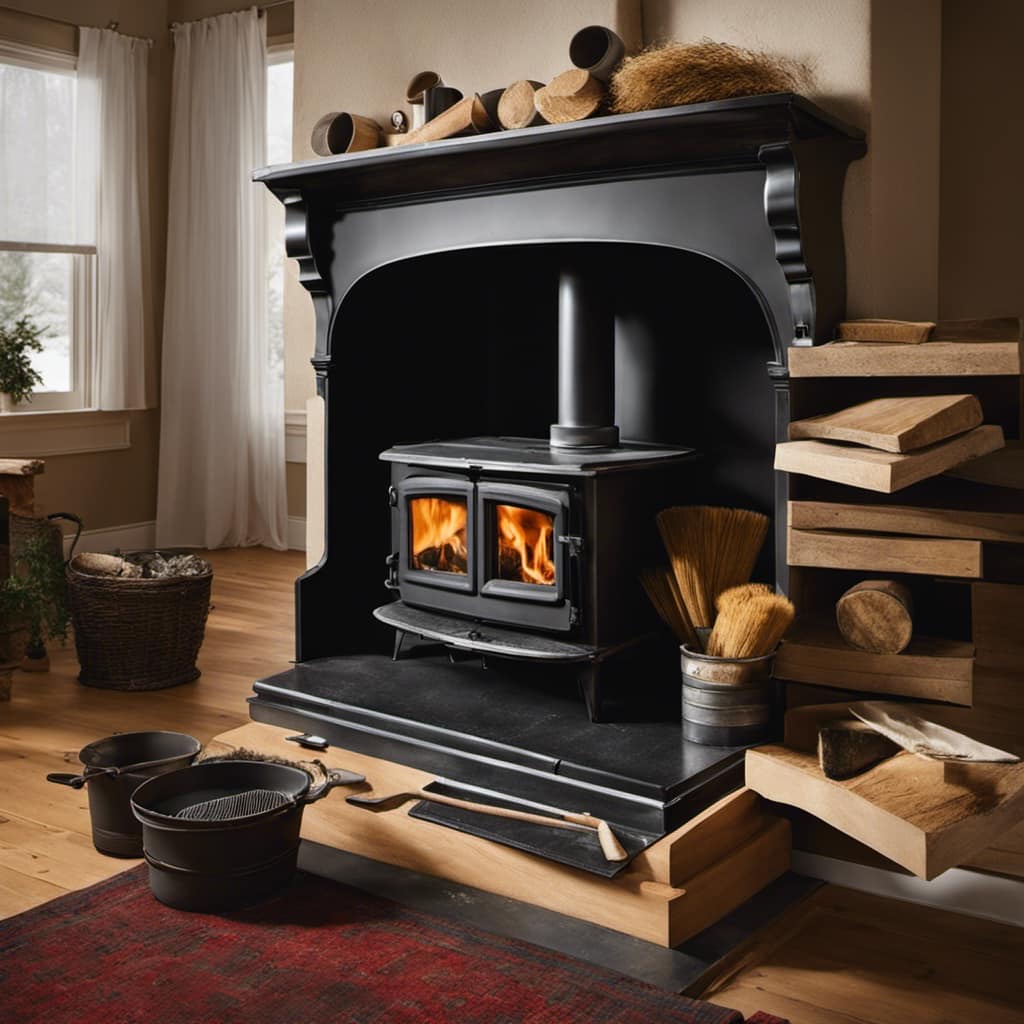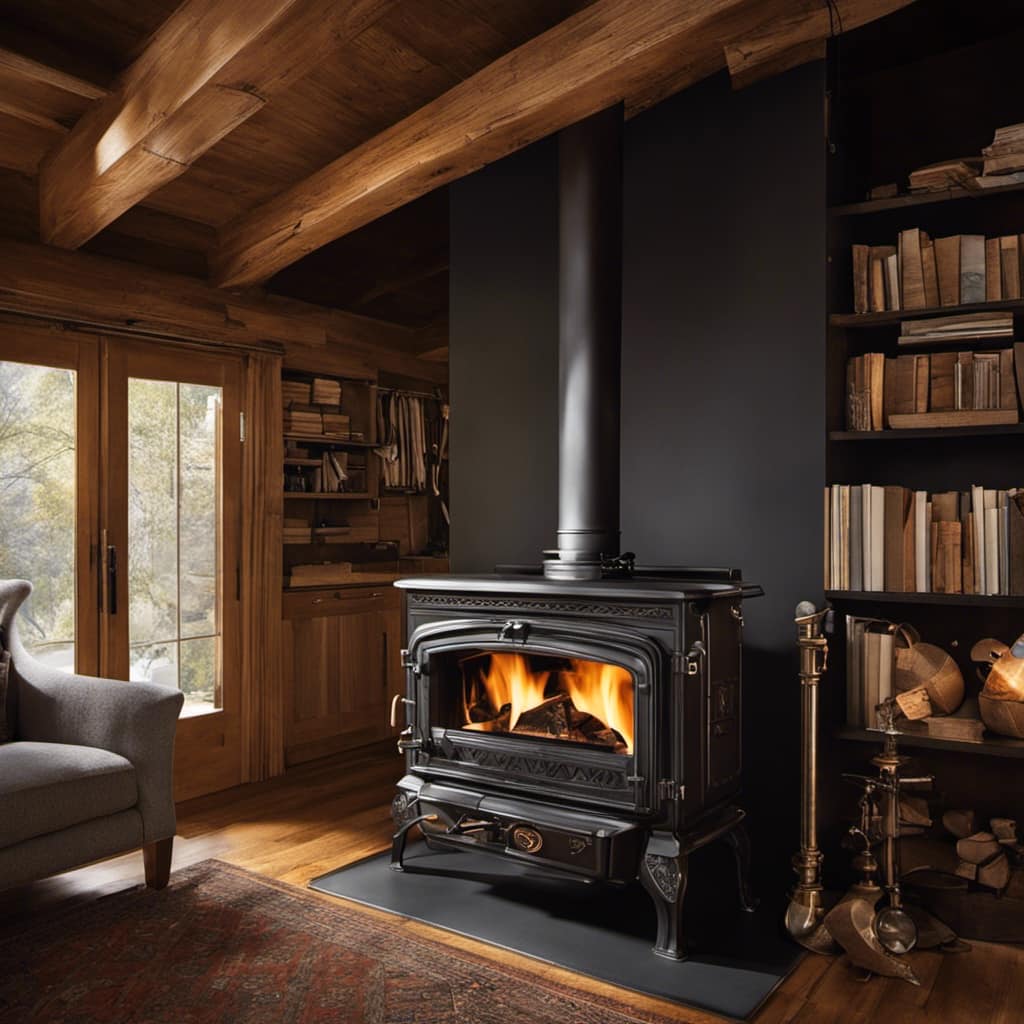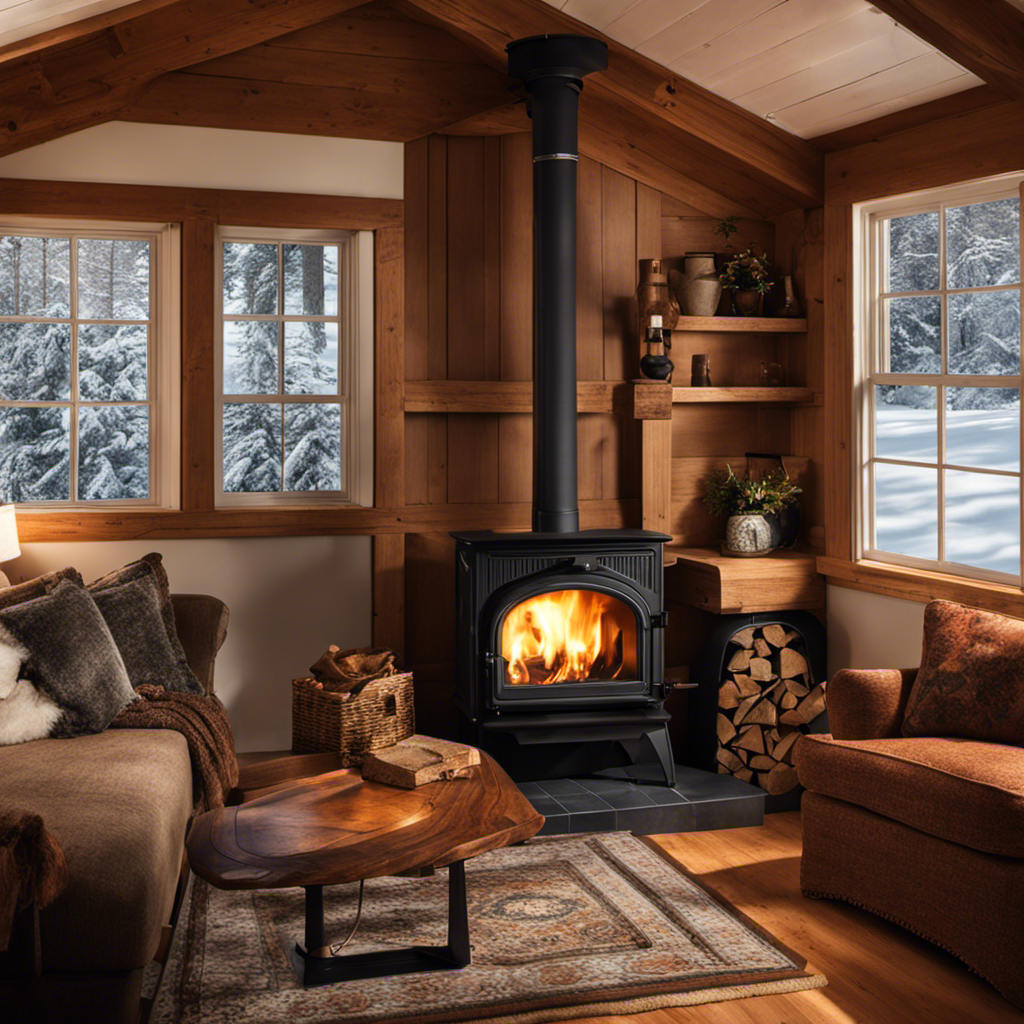
As a homeowner, I have always been intrigued by the inner workings of my wood stove. I find it fascinating to observe the graceful dance of flames juxtaposed with the complex yet silent processes that occur behind the scenes.
In this article, we’ll delve into the technical aspects of how a wood stove operates. From the combustion process to heat transfer mechanisms, we’ll explore the science behind this reliable source of warmth.
So, let’s dive in and uncover the secrets of how a wood stove truly works.
Key Takeaways
- The wood stove relies on the combustion process to generate heat.
- Proper installation and ventilation are crucial for optimal functioning of the wood stove.
- Heat is transferred through convection and conduction mechanisms in the wood stove.
- Effective heat distribution and temperature control are essential for comfort.
Combustion Process
I can feel the warmth radiating from the wood stove as the combustion process occurs.

The ignition temperature of the fuel source, which in this case is wood, is crucial for the wood stove to work effectively. When the wood is heated to a certain temperature, usually around 300 degrees Celsius, it undergoes a chemical reaction known as combustion.
This process involves the wood combining with oxygen from the air, producing heat, light, and various byproducts such as carbon dioxide and water vapor. The wood stove provides the ideal environment for this combustion process to take place, with its enclosed space, controlled airflow, and insulation.
As the wood burns, it releases energy in the form of heat, warming the room and creating a cozy atmosphere.
Air Supply and Ventilation
To ensure proper operation, I need to make sure there’s sufficient air supply and ventilation for the wood stove. Maintaining good airflow is crucial for the efficient combustion of wood and the prevention of harmful byproducts. Proper installation is of utmost importance to ensure the wood stove functions optimally.

Here are some key points to consider regarding air supply and ventilation:
- Proper installation ensures that the stove is placed in a well-ventilated area, away from combustible materials.
- Sufficient air supply is necessary for complete combustion, resulting in a cleaner and more efficient burn.
- Proper ventilation helps to remove smoke, reducing indoor air pollution and improving air quality.
It is essential to prioritize the importance of proper installation and the environmental impact and sustainability associated with wood stoves.
Now, let’s delve into the next section about heat transfer mechanisms.
Heat Transfer Mechanisms
One way heat is transferred from the wood stove to the surrounding area is through convection. As the fire burns inside the stove, the air inside gets heated and rises. This creates a convection current, where the hot air moves upwards and is replaced by cooler air from the surrounding area. This process continues as long as the fire is burning, resulting in a continuous flow of hot air from the stove into the room.

Another mechanism of heat transfer in a wood stove is conduction. When the stove becomes hot, the heat is conducted through the walls of the stove and into the surrounding air. This is why the sides of the stove often feel warm to the touch. The heat is then transferred from the air to other objects in the room through conduction. This means that any objects in direct contact with the hot air or the stove will also absorb and radiate heat.
Distribution of Heat
The distribution of heat in my living room is influenced by the convection currents created by the wood stove. As the fire burns, the stove heats up and radiates heat into the room. However, the heat isn’t evenly distributed throughout the space.
To ensure effective heat distribution and temperature control, I employ the following strategies:
-
Positioning: Placing the wood stove in a central location allows for better heat distribution throughout the room.

-
Ceiling fans: Running ceiling fans in a clockwise direction helps to push warm air down from the ceiling, promoting better circulation and distribution.
-
Vents and ducts: Installing vents and ducts in the floor or walls helps to direct warm air to cooler areas, ensuring more even heat distribution.
Efficiency and Maintenance
I regularly clean and inspect my stove to ensure its efficiency and prevent any potential issues. Maintaining a wood stove is essential for cost-effective heating and minimizing its environmental impact. Here is a table showcasing the key maintenance tasks and their recommended frequency:
| Maintenance Task | Frequency |
|---|---|
| Ash Removal | Weekly |
| Chimney Cleaning | Annual |
| Check Gaskets and Seals | Monthly |
| Clean Glass Door | Monthly |
| Check for Creosote Buildup | Monthly |
Regularly cleaning out the ash and creosote buildup ensures optimal burning efficiency while reducing the risk of chimney fires. Cleaning the glass door and checking gaskets and seals prevent any air leaks, improving the stove’s efficiency. Annual chimney cleaning removes any blockages, ensuring proper ventilation. By following these maintenance guidelines, I can enjoy cost-effective heating while minimizing my wood stove’s environmental impact.

Frequently Asked Questions
What Are the Different Types of Wood Stoves Available in the Market?
There are different types of wood stoves available in the market. Traditional wood stoves have a rustic design, while modern ones have advanced features. Freestanding stoves are standalone units, while inserts are installed into existing fireplaces.
Can a Wood Stove Be Used as the Primary Source of Heating for a Home?
Using a wood stove as the primary heat source has its pros and cons. It provides a cozy, rustic feel and can save on utility bills, but requires regular maintenance and may not distribute heat evenly. To maximize efficiency, ensure proper ventilation and use dry, seasoned wood.
Are There Any Safety Precautions That Need to Be Taken While Using a Wood Stove?
When using a wood stove, safety precautions are crucial. Regular maintenance is necessary to prevent hazards like chimney fires. Ensure proper ventilation, use a sturdy hearth, and keep flammable materials away.
How Long Does It Take for a Wood Stove to Heat up a Room?
It depends on the size of the room, insulation, and wood quality. Heating efficiency is influenced by these factors. A wood stove can take anywhere from 30 minutes to a few hours to heat up a room.

What Factors Should Be Considered When Selecting the Right Size of a Wood Stove for a Specific Room?
When selecting the right size wood stove for a specific room, factors such as room size, insulation, and desired heat output should be considered. These factors affect wood stove efficiency and performance.
Conclusion
In conclusion, wood stoves are an efficient and reliable source of heat. This is due to their combustion process, air supply and ventilation system, heat transfer mechanisms, and distribution of heat. They provide warmth and comfort to homes while reducing reliance on fossil fuels.
As the saying goes, ‘A wood stove today keeps the chill away.’ Regular maintenance is essential to ensure optimal performance and safety. With proper care and attention, wood stoves can be a cost-effective and environmentally friendly heating solution.
Growing up surrounded by the vast beauty of nature, Sierra was always drawn to the call of the wild. While others sought the comfort of the familiar, she ventured out, embracing the unpredictable and finding stories in the heartbeat of nature.
At the epicenter of every remarkable venture lies a dynamic team—a fusion of diverse talents, visions, and passions. The essence of Best Small Wood Stoves is crafted and refined by such a trio: Sierra, Logan, and Terra. Their collective expertise has transformed the platform into a leading authority on small wood stoves, radiating warmth and knowledge in equal measure.










